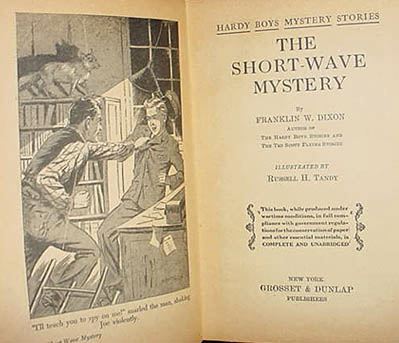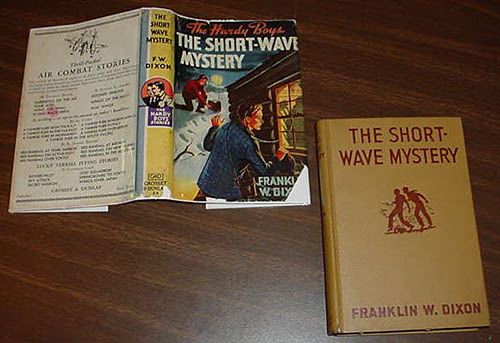| |
|
"The Hardy Boys - The Short-Wave Mystery" by Franklin W. Dixon
Reviewed by Richard McVicar
 A
book that I believe may be appealing to fellow static-listeners
is one you may have read years ago. If you first enjoyed
it before the delights and mysteries of the ionosphere began mixing
with the blood and coffee in your veins, you may find that today
you would be reading it in a more critical light. That is
not to say you would not return with a smile to the amazing and
exciting world of two young Bayport sleuths, Frank and Joe Hardy.
This world also includes, among others, chum Chet Morton and his
appetite, dad Fenton Hardy and his brain and Aunt Gertrude and
her tirades.
A
book that I believe may be appealing to fellow static-listeners
is one you may have read years ago. If you first enjoyed
it before the delights and mysteries of the ionosphere began mixing
with the blood and coffee in your veins, you may find that today
you would be reading it in a more critical light. That is
not to say you would not return with a smile to the amazing and
exciting world of two young Bayport sleuths, Frank and Joe Hardy.
This world also includes, among others, chum Chet Morton and his
appetite, dad Fenton Hardy and his brain and Aunt Gertrude and
her tirades.
The Short-Wave Mystery is the 24th in this series of boyhood favorites. This particular story was first published in 1945 by Grosset & Dunlap, and, like the others in the series, was written in two steps. First, a plot outline was sketched by Harriet S. Adams. Harriet was a daughter of Edward Stratemeyer, founder of the Stratemeyer Syndicate, a company which has turned out juvenile series books by the hundreds throughout the past century. The outline was then sent to Canadian writer Leslie McFarlane, one of the syndicate's "ghost writers" and first "ghost" of the Hardy Boys series. (The author listed with the books' titles, "Franklin W. Dixon," is as much a fiction as are the stories.) McFarlane, following the pre-sketched plot, smithed out the actual words. This two-step, plotter-author combination was how all of the Hardy Boy books, Nancy Drew, Radio Boys, and many other juvenile series books were put together.
The story begins in the Hardy home attic with brothers Frank and Joe attempting to reach their chunky pal, Chet Morton, by way of a short-wave radio. After a brief conversation with Chet, the boys twiddle the dial for a few minutes and stumble across a strange voice, "little more than a whisper," exclaiming "Help . . . Hudson." A new mystery was afoot!
The story involves the theft of radio parts and how they are craftily hidden in stuffed animals (not teddy bears but real animals having undergone taxidermy). This leads to 217 pages of casing stores, following suspects, clonks on the head, deductions, and an exciting airplane chase to Canada's Hudson Bay country to catch a gang leader and also, hopefully, to find a few missing scientists. To learn more of the plot, you'll need to read the book itself.
Chet Morton's newest passion is, coincidentally, taxidermy. Indeed, McFarlane weaves a great deal of his usual humour into this story by way of Chet, especially with issues pertaining to the girthy lad's appetite and frustrations in learning how to stuff dead animals. Another regular character, and an invention of McFarlane himself, is the boy's Aunt Gertrude, a "peppery spinster" who loves to give verbal lashings to her beloved nephews. It has been speculated, even by McFarlane himself, that the frightening but soft-on-the-inside Aunt Gertrude may have been the secret to the incredible success of The Hardy Boys series. The Short-Wave Mystery contains plenty of Aunt Gertrude passages, a couple of which involve entertaining (to the reader) encounters with Chet's animal projects.
There are a number of occurrences and coincidences which are hard to swallow, but this gives one the opportunity to practice the discipline of suspension of belief (or is that disbelief?). One such instance involves the use of a walkie-talkie antenna to subdue and kill an attacking lynx. Of course, this might work. I've never tried it. Not even on a DXpedition.
While shortwave radio is used to communicate great distances, most of its use in this story is akin to CB or two-meter radio. Neither Adams, the plot-sketcher, nor McFarlane, the writer, seem to have a grasp on what shortwave really is. Indeed, Frank Hardy offers an awful explanation of how shortwave works on page 79 of the original edition:
"Think of lightning. You know how jagged that is sometimes."
"You mean it's not a straight line? It goes up and down and has lots of points to it?" asked Jimmy.
"That's right. Well, radio waves are like that, only you can't see them," said Frank. "The more points they have and the narrower the line is, the farther the waves can travel."
Huh?
I understand that changes in the 1954 text include using a piano analogy in this passage rather than that of lightning. Other updates include changing the call letters to legally reflect those in use in the U.S. (The Hardy home station is "VN16J" in the original text.)
 I read perhaps a third of the Hardy Boys series the year before I sent my first reception report, that is, when I was 12.看 Today I collect early editions and read them to my kids.看 Both activities bring a great deal of enjoyment.看 First editions of The Short-Wave Mystery pop up from time to time on eBay, with bidding sometimes staying under $15, even for one in a good quality dust jacket.看 Early editions in general are always available for bidding.看 Antiquarian book stores are also good places to look, but don't pay more than a buck or two if it doesn't have a jacket. (Tip:看 Only the very first printing contains a Wartime Paper notice on the title page.)
There is a collectible oddity with the third printing--It's the
only Hardy Boy book to have a maroon cover. Revised text
(1966) editions are still sold at your local book store.
(Another tip for series collectors--Don't let the copyright date
fool you. Subsequent printings that continue for decades
can still contain the original copyright date.)
I read perhaps a third of the Hardy Boys series the year before I sent my first reception report, that is, when I was 12.看 Today I collect early editions and read them to my kids.看 Both activities bring a great deal of enjoyment.看 First editions of The Short-Wave Mystery pop up from time to time on eBay, with bidding sometimes staying under $15, even for one in a good quality dust jacket.看 Early editions in general are always available for bidding.看 Antiquarian book stores are also good places to look, but don't pay more than a buck or two if it doesn't have a jacket. (Tip:看 Only the very first printing contains a Wartime Paper notice on the title page.)
There is a collectible oddity with the third printing--It's the
only Hardy Boy book to have a maroon cover. Revised text
(1966) editions are still sold at your local book store.
(Another tip for series collectors--Don't let the copyright date
fool you. Subsequent printings that continue for decades
can still contain the original copyright date.)
Enjoy the book and, if you insist on an early edition, enjoy the sleuthing! You may be weaving a new hobby in with an old.